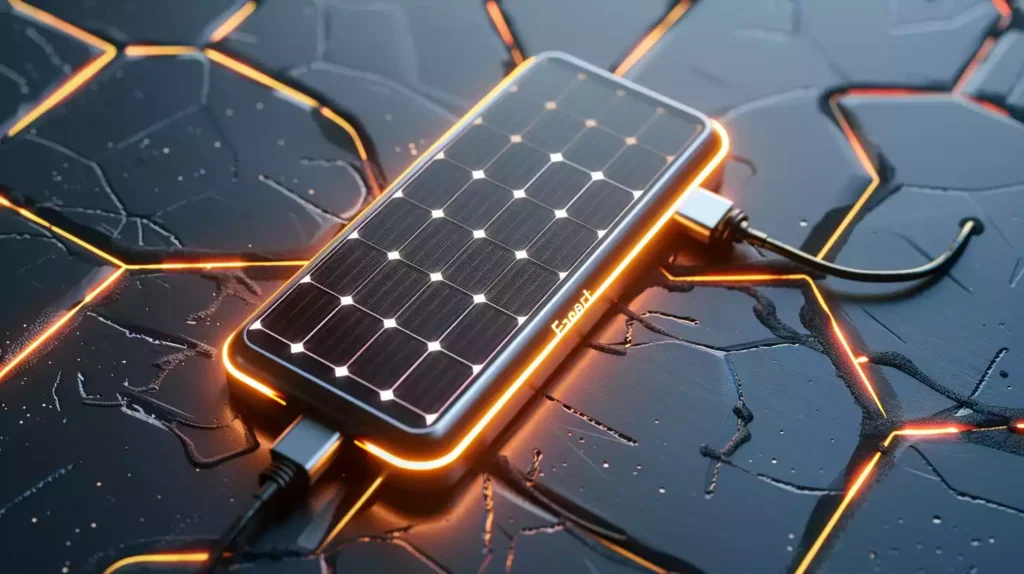Can You Solar Charge a Battery While Using It? (Simple Tips!)
Charging a battery with solar power while using it is completely achievable! Ensure your solar panel matches your battery’s energy requirements, and select a suitable charge controller.
Match the amperage rating of the charge controller to the solar panel’s wattage. Consider an MPPT controller for improved efficiency. Inspect your system regularly for peak performance.
Keep an eye on your battery’s voltage and maintain proper wiring connections. Remember, balancing energy use and generation is crucial for maximizing your battery’s lifespan.
Want to know more about maximizing solar charging efficiency and battery performance?
Quick Summary
- Use an MPPT charge controller for efficient energy transfer while charging and using the battery simultaneously.
- Ensure solar panel wattage matches battery energy requirements for continuous charging during use.
- Monitor battery voltage to prevent overcharging or undercharging while drawing power from the battery.
- Optimize power management to distribute loads evenly and maintain battery performance during charging and usage.
- Regularly inspect wiring connections and charge controller indicators to ensure safe and efficient charging while using the battery.

Solar Panel Selection
When selecting a solar panel for charging a battery in use, make sure its wattage output aligns with the energy requirements of the battery. The solar panel needs to provide sufficient power to charge the battery effectively.
To guarantee compatibility, calculate the amperage required for the charge controller by dividing the solar panel watt rating by the battery voltage. This calculation helps in determining if the solar panel can deliver the necessary energy to charge the battery efficiently.
Choosing the right solar panel is essential for the overall performance of the charging system. Opting for a solar panel that matches the energy needs of the battery charger is key to ensuring a successful charging process.
Selecting a solar panel that’s compatible with the charge controller is critical to prevent any damage to the battery and ensure the system operates smoothly.
Charge Controller Matching
When it comes to solar charging a battery while in use, one important aspect is matching the charge controller to the solar panel output.
It’s essential to guarantee that the charge controller’s amperage rating aligns with the wattage of the solar panel to safeguard your battery against damage.
Going with an MPPT charge controller can enhance energy efficiency, offering an ideal solution for your solar setup.
Controller Specifications and Compatibility
To guarantee the safe and efficient operation of your solar charging system, it’s essential to choose a charge controller that aligns with the output of your solar panels to avoid potential harm to the battery.
Matching the solar watt rating to the battery voltage helps determine the necessary amps for the charge controller.
An MPPT charge controller can greatly enhance energy storage and transfer efficiency. Make sure the charge controller is mounted in a grounded location, away from harsh elements, to promote safety. Regularly inspect the controller for wear or damage to maintain peak performance levels.
Selecting a compatible charge controller is critical for the longevity and effectiveness of your solar charging setup.
Optimal Charge Controller Selection
Selecting an MPPT charge controller for your solar charging system can greatly enhance energy storage and transfer efficiency compared to PWM controllers. Matching the charge controller rating to the calculated amperage needed is essential to prevent battery damage and optimize charging.
Considering potential future upgrades to MPPT controllers can lead to increased efficiency in solar charging systems. It’s important to check the solar panel wattage and battery voltage to select a suitable charge controller for best performance.
While budget-friendly PWM controllers can be a good starting point for beginners in solar charging setups, investing in an MPPT controller can greatly improve the overall effectiveness and longevity of your battery. Making the right charge controller choice is key to maximizing the performance of your solar charging system.
MPPT Controller Benefits
Maximizing solar panel efficiency, MPPT controllers can greatly enhance energy transfer to batteries compared to PWM controllers. These controllers are like the brain of your solar power system, constantly scanning and adjusting to find the optimal power point of the solar panel.
By doing so, they guarantee that the most power possible is being extracted from the sunlight and efficiently transferred to your battery. This optimization can increase solar panel efficiency by up to 30%, a significant boost when aiming for maximum energy production.
MPPT charge controllers are particularly beneficial for systems that experience varying sunlight conditions or shading. They excel at converting excess voltage into additional current, which translates into faster charging times and higher energy production.
Investing in an MPPT controller not only leads to more efficient battery charging but also contributes to overall system performance. So, if you’re looking to get the most out of your solar power setup, an MPPT controller is definitely worth considering.
System Inspection Tips
When it comes to ensuring the smooth operation of a solar charging system, checking the wiring connections and monitoring the charging performance are essential steps.
By inspecting the solar panel connections for proper alignment and secure wiring, you can maximize energy production efficiently.
Regularly monitoring the charge controller for wear and the battery voltage during charging will help prevent issues like overcharging and maintain peak performance.
Check Wiring Connections
Inspecting the wiring connections is important to guaranteeing the proper functioning of the solar charging system. To effectively charge the battery while using it, it’s essential to confirm that the positive and negative wires are correctly attached to the battery posts.
Moreover, make sure to securely insert the wires into the charge controller‘s input ports to maintain a steady power flow. Connecting the wires from the charge controller to the solar panel is crucial for the efficient transfer of solar-generated electricity.
Monitor Charging Performance
To effectively monitor the charging performance of a solar system, regularly check the solar panel output voltage to confirm it meets the battery’s requirements.
It’s essential to inspect the charge controller performance indicators for efficient energy transfer and verify proper battery voltage levels to avoid overcharging or undercharging. Moreover, always examine the wiring connections for any signs of corrosion or damage that could impact the charging process.
By keeping an eye on these key aspects and regularly reviewing the system’s overall performance, you can identify and address any issues promptly, ensuring your battery is effectively charged while in use.
| Monitoring Component | What to Check | Why It’s Important |
|---|---|---|
| Solar Panel Output Voltage | Alignment with Battery Needs | Ensures efficient charging |
| Charge Controller Indicators | Performance Status | Indicates healthy energy transfer |
| Battery Voltage Levels | Avoid Over/Undercharging | Preserves battery lifespan |
| Wiring Connections | Corrosion or Damage | Maintains reliable charging connections |
Monitoring Charging Progress
I regularly check the battery voltage to monitor the charging progress when solar charging a battery in use. By measuring the voltage with a multimeter, I can accurately track the current flowing into the battery.
Observing the LED indicators on the charge controller provides valuable insights into the charging status. These indicators give me a quick way to assess how efficiently the battery is being charged.
It’s also important to keep an eye on the battery temperature, as it can indicate the overall charging efficiency. To further enhance monitoring, using a battery monitor with a display allows me to track the charging process in real-time, giving me a detailed view of how the solar charging is progressing.
Battery Voltage Maintenance

Regularly checking the battery voltage is vital to maintaining peak performance and longevity, ensuring efficient operation while preventing overcharging or deep discharging. By monitoring the voltage levels, you can keep the battery charges and discharges within the ideal range, extending its lifespan.
Voltage fluctuations can greatly impact the battery’s performance and overall health, so it’s essential to use a multimeter for accurate measurements and adjust the charging system as needed. Maintaining the correct voltage levels is like giving your battery the right fuel to function optimally; it’s the secret sauce for maximizing its lifespan and performance.
Think of it as the battery’s duty cycle – keeping it within the right voltage range is like maintaining a healthy routine for your device. So, stay vigilant with your voltage checks, and your battery will thank you with long-lasting, reliable power.
Wiring Connection Safety
Using appropriate wire gauge is essential for handling the current flow between solar panels, PWM charge controller, and battery while ensuring safe and efficient operation. Proper wire gauge guarantees that the electrical current can flow without encountering resistance that may lead to overheating or power loss.
When connecting the solar panels to the charge controller and then to the battery, it’s important to use the right gauge wire that can handle the current produced by the panels without overheating or causing voltage drop.
Inspecting and securing all wiring connections is crucial to prevent any loose connections that could compromise the system’s efficiency or even pose safety risks.
Ensuring that all wires are properly insulated helps prevent short circuits and electrical shocks. Labeling wires and components aids in easy identification and troubleshooting if any issues arise. Regularly checking for wear, damage, or corrosion in the wiring connections is vital to maintain the system’s efficiency and safety.
Solar Charging Efficiency
Enhancing solar charging efficiency requires optimizing the balance between power generation and consumption. By utilizing MPPT controllers, solar charging can reach up to 30% efficiency.
These controllers work by adjusting the solar panel’s electrical operating point for maximum power output, ensuring that the energy harvested is utilized effectively. Factors such as sunlight intensity and panel orientation play pivotal roles in determining the overall charging efficiency.
Regular maintenance of solar panels is also essential to sustain and enhance their performance over time.
MPPT controllers act as the brains behind the operation, constantly monitoring and adjusting the voltage and current to extract the maximum power available from the solar panels. This optimization process significantly boosts the charging efficiency, making the most out of the solar energy harnessed.
Understanding how these controllers function and incorporating them into the solar charging system can lead to substantial improvements in efficiency, allowing for more effective utilization of solar power.
Battery Use Optimization
To optimize battery use, one must carefully manage loads and charging cycles, ensuring efficient utilization of energy.
- Utilize Power Management: Make sure to distribute power loads evenly to avoid overworking the battery during both charging and discharging. By managing power effectively, you can extend the battery’s lifespan and maintain its performance over time.
- Monitor Charging Cycles: It’s essential to keep a close eye on the battery’s charging cycles to prevent overcharging or undercharging, which can impact its efficiency and longevity. Adjusting charging settings and using timers can help optimize these cycles for better overall performance.
- Balance Discharging and Charging: To maximize battery use, make sure to balance the rate of discharging and charging. This equilibrium is important for efficient energy utilization and can help prevent excessive strain on the battery, ensuring it lasts longer and functions efficiently.
